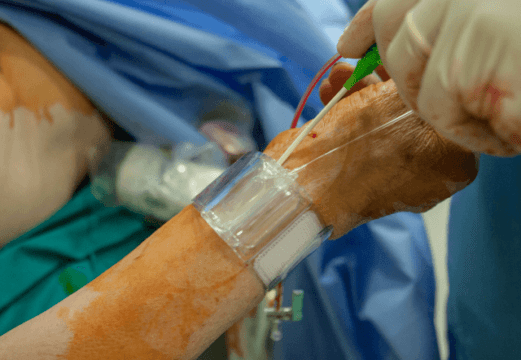The first experiences with distal radial access (DRA) have revealed significant benefits compared against the transradial approach (TRA), showing reduced bleeding events and better puncture site occlusion rate. Even the spectrum of diseases treated with DRA has grown, and now includes chronic total occlusion (CTO) though 7Fr inductors, such as Terumo’s Glidesheath Slender.

The aim of this study presented by Lee et al. was to assess the safety and feasibility of DRA in coronary procedures, in a real world population. This analysis was based on the KODRA (Korean Prospective Registry for Evaluating the Safety and Efficacy of Distal Radial Approach), which included patients over 20, with a palpable distal radial artery (classified into quite good, good and weak pulse). It excluded patients with positive modified Allen test, and pregnant or breastfeeding women.
Choosing between right or left DRA was left to operator discretion, which resulted in 60% opting for a left DRA and 40% right. After lidocaine administration, the distal radial artery was punctured with a 20g needle at the anatomical snuffbox or dorsal aspect of the hand, guided by ECG. This was followed by a coronary angiogram, with or without PCI, according to local protocol, and the recommended compression with optimal pressure and for the minimal necessary time.
Access site complications included distal radial occlusion (DRAO), radial occlusion (RAO), numbing, discomfort and swelling. primary endpoints were the success rates of coronary angiography (CAG) and percutaneous coronary intervention (PCI). The secondary endpoints included successful distal radial artery puncture, access-site crossover, puncture time, time to hemostasis, bleeding events and complications. The BARC standard was used to assess bleeding and the EASY to assess hematomas.
Between September 2019 and September 2021, 4977 patients from 11 hospitals in South Korea were included in the study. Mean age was 66.4 ±11.9, and 67.6% were men. 7.2% presented chronic kidney disease and 2.5% was in dialysis. The main indication for the procedure was stable angina (26.2%), followed by unstable angina (22.2%), non-STEMI (10.6%), and STEMI (4.5%).
There was 6.7% puncture site crossover (4.2% to radial on the same side and 1.3% transfemoral), the main cause being failed puncture. DRA puncture success rate was 94.4%, with mean 60 second puncture time, most often at the anatomical snuffbox (84.4%). Enrolled patients often presented quite good and good pulse (86.4%). Procedural success rate with coronary angiogram was 100%, and 98.8% with PCI. Cause of failure included 8 attempts at CTO, 3 failed crossover attempts, and one case of balloon related rupture.
On average, close to 5.3% of access sites presented complications. Bleeding events were 3.3% (BARC-1 1.1% and BARC-2 2.2%), and hematoma occurrence according to EASY 1a was 3.1%, mainly within 2 cm of the puncture site. There were only 7 cases of hematoma beyond the hand, with one case of forearm swelling. At one month followup, DRAO incidence was 1.1%, and RAO was also 1.1% (verified with doppler). As regards procedure related adverse events, 0.9% presented prolonged numbing during the first month.
Read also: TAVR in Low Risk Patients: 10 Year Evolution.
At logistic regressing, the presence of weak pulse (OR: 9.994; 95% CI: 7.252-13.774) and poor DRA experience (<100 cases) (OR: 2.187; 95% CI: 1.383-3.456) were identified as predictors of failed puncture.
Conclusions
DRA analysis as primary approach, through the KODAS registry, showed a very good success rate, with 100% for diagnosed procedures and 98.8% for therapeutic procedures, with low rates of DRAO and RAO (0.8% at one month through palpation). Safety rates are reliable, with only 3.3% of minor bleeding (BARC 1 y 2).

Dr. Omar Tupayachi.
Member of the Editorial Board of SOLACI.org.
Original Title: Distal Radial Access for Coronary Procedures in a Large Prospective Multicenter Registry. The KODRA Trial.
Reference: Lee JW, Kim Y, Lee BK, Yoo SY, Lee SY, Kim CJ, Jin HY, Park JS, Heo JH, Kim DH, Lee JB, Kim DK, Bae JH, Lee SY, Lee SH. Distal Radial Access for Coronary Procedures in a Large Prospective Multicenter Registry: The KODRA Trial. JACC Cardiovasc Interv. 2024 Feb 12;17(3):329-340. doi: 10.1016/j.jcin.2023.11.021. PMID: 38355261.
Subscribe to our weekly newsletter
Get the latest scientific articles on interventional cardiology





